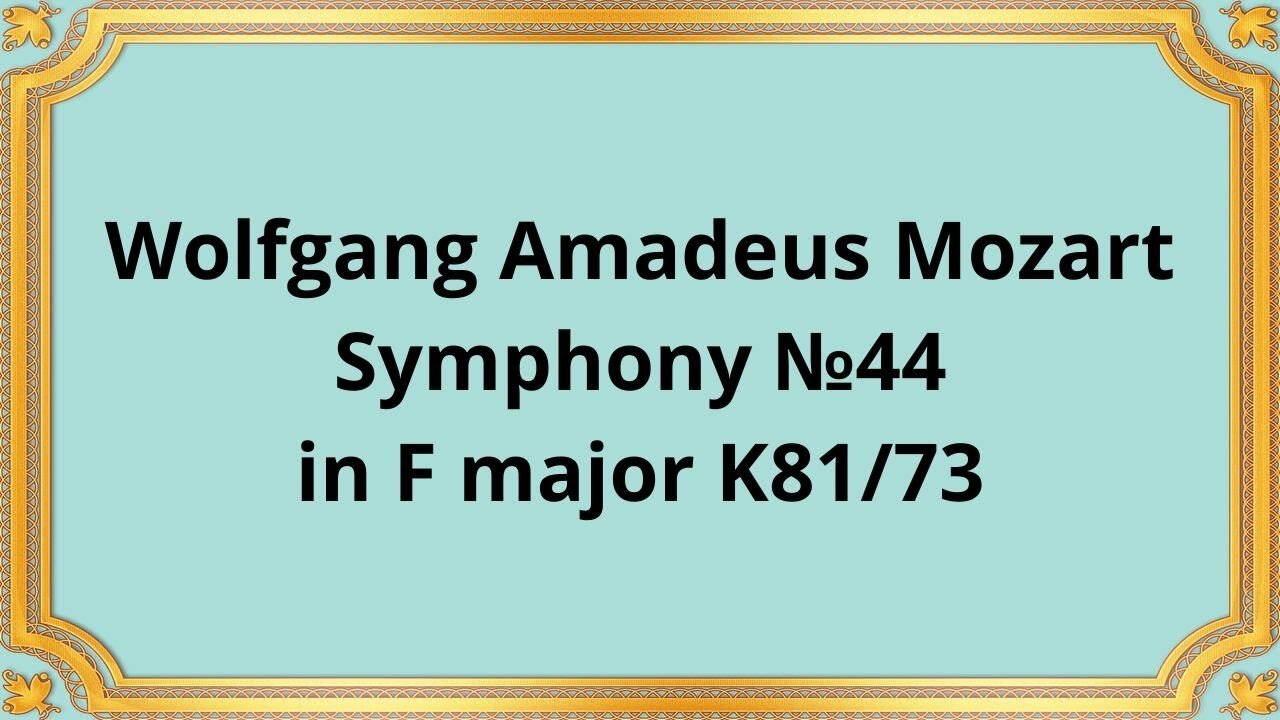Premium Only Content

Wolfgang Amadeus Mozart Symphony №44 in F major K81/73
Wolfgang Amadeus Mozart's Symphony No. 44 in F major, K81/73, is a fascinating piece of music that displays the young composer's prodigious talent. This symphony is one of Mozart's early works, composed when he was only 9 years old. In this essay, we will explore the history and significance of Symphony No. 44 in F major and examine its structure, instrumentation, and musical themes. Symphony No. 44 in F major was composed by Mozart in 1768 when he was only 9 years old. The piece was likely intended to be performed at a concert or as part of a church service. The symphony was not published during Mozart's lifetime, and it remained relatively unknown until the 20th century when it was rediscovered and given the nickname "Trauer," which means "mourning" in German.
Despite its relative obscurity, Symphony No. 44 in F major is an important work in Mozart's early development as a composer. It showcases his incredible talent for melody and harmony and gives us a glimpse into the mind of a young musical genius.
Symphony No. 44 in F major is written in the standard four-movement form of classical symphonies. The first movement is marked Allegro spiritoso and features a bright and lively melody played by the strings. The movement is characterized by its playful rhythms and cheerful melodies.
The second movement is marked Andante and features a beautiful, lyrical melody played by the oboes and then taken up by the strings. The movement is notable for its use of chromaticism, a technique in which the composer uses notes that do not belong to the key of the piece to create tension and interest.
The third movement is marked Menuetto and Trio and is a lively dance in triple meter. The movement features a playful melody in the strings that is punctuated by the horns and woodwinds.
The final movement is marked Presto and is a fast and lively finale. The movement features a virtuosic solo violin part and a thrilling coda that brings the piece to an exciting conclusion.
Symphony No. 44 in F major is scored for a standard classical orchestra, which includes two oboes, two horns, and strings.
Symphony No. 44 in F major is known for its inventive and memorable melodies, which are developed and transformed throughout the work. One of the most prominent themes in the first movement is a bright and lively melody played by the strings. This melody is developed and transformed throughout the movement, creating a sense of unity and coherence.
The second movement features a beautiful, lyrical melody played by the oboes and then taken up by the strings. The movement is notable for its use of chromaticism, which creates a sense of emotional depth and complexity.
The third movement features a playful melody in the strings that is punctuated by the horns and woodwinds. This melody is developed and transformed throughout the movement, creating a sense of variety and interest.
The final movement features a virtuosic solo violin part that adds a sense of excitement and energy to the piece. The movement builds to a thrilling coda that brings the symphony to an exciting conclusion.
Conclusion
Wolfgang Amadeus Mozart's Symphony No. 44 in F major, K81/73, is a fascinating piece of music that showcases the young composer's prodigious talent. Despite its relative obscurity, the symphony is an important work in Mozart's early development as a composer and gives us a glimpse into the mind of a young musical genius.
-
 31:06
31:06
Classical music_Music Inspiration
1 month agoPyotr Ilyich Tchaikovsky Piano Concerto No. 1 in B-flat minor
571 -
 1:08:04
1:08:04
Sean Unpaved
2 hours agoGridiron Shocks: Arch's Rough Start, Belichick's Tar Heel Tumble, & NFL Week 1 Buzz
6.15K -
 LIVE
LIVE
Professor Nez
1 hour ago🚨🇺🇸President Trump makes MAJOR Announcement from Oval Office TODAY!
177 watching -
 1:05:22
1:05:22
Timcast
2 hours agoLiberals Claim TRUMP DIED Or Is Dying And Will RESIGN Today At 2pm
103K99 -
 1:47:55
1:47:55
The Dilley Show
2 hours ago $11.42 earnedChicago in the Crosshairs, Grifters Crash Out and More! w/Author Brenden Dilley 09/02/2025
45K3 -
 LIVE
LIVE
StoneMountain64
1 hour agoBattlefield Portal has already been better than I realized
94 watching -
 LIVE
LIVE
Viss
2 hours ago🔴LIVE - How To Win in PUBG - PUBG 101
139 watching -
 10:04
10:04
Adam Does Movies
19 hours ago $0.03 earnedMortal Kombat II Delayed, Harry Potter Drama & Disney Reveal - Movie News
377 -
 1:54:43
1:54:43
Side Scrollers Podcast
3 hours agoVoice Actor ROASTED For Racist Double Standard + Influencer FELONY After Con Threat | Side Scrollers
2.65K2 -
 LIVE
LIVE
The Amber May Show
1 hour agoTruth Under Fire: Smears, Shootings & Political Power Plays
37 watching